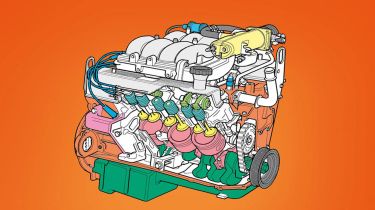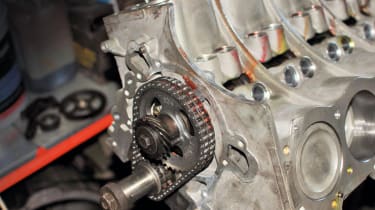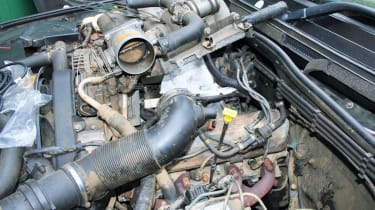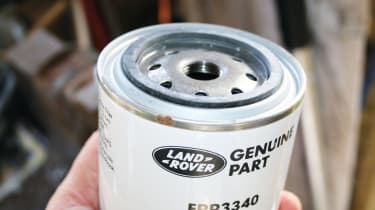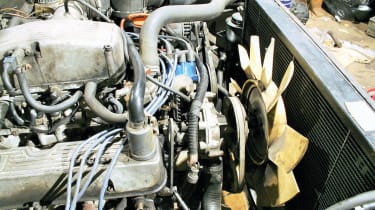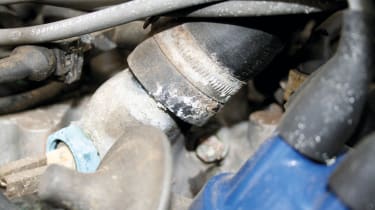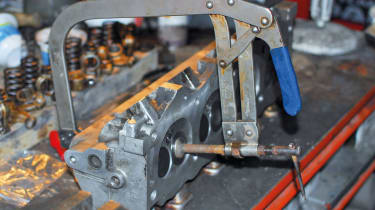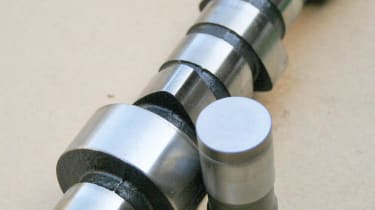Make your V8 last forever
Familiarity with your V8 engine, its peculiarities and its needs, all helps to maintain performance and longevity
The Rover V8 is still one of my all-time favourite engines. It may not be the most powerful V8, but its simplicity and light weight have made it the star of a great many vehicles over the decades. It started out as a Buick design launched in 1960. Back then it was a very contemporary design with aluminium block and heads for low weight. But it was a little ahead of its time and its small size and need for special coolant put US customers off.
The design and tooling was subsequently bought by Rover in 1965 and significantly modified and fitted with twin SU carburettors to suit the Rover P5b saloon. Then, in 1970, the compression ratio was lowered for the first Range Rover. Shortly after that, it appeared in the 101 Forward Control military Land Rover, and then in the Series 3 Stage One V8 as a precursor to the Defender V8.
The launch of the Discovery in 1989 was the last new application for the twin carburettor 3.5-litre V8 engine. After that, fuel injection was required on any new type of vehicle. The V8 was enlarged to 3.9-litres in 1994 and continued to be used in Range Rover and Discovery. It also briefly appeared in the Defender SV90. In 1992, a longer stroke 4.2-litre version was introduced in the Range Rover LSE. When the bore was stretched for the 3.9-litre mill, the cylinder liners were not held quite so well as in the 3.5 engine, and they have a tendency to creep down which, in turn, compromises the cylinder head gasket clamping efficiency, and gasket leaks are then common. Engines with this fault are expensive to fix properly, although it has to be said the fault can usually be ‘lived with’ if not too severe. The results of this problem are a tendency to blow coolant out, resulting in overheating, and in some cases a tendency to burn a bit more oil than usual but, if the coolant gets into the oil, then the engine will quickly destroy itself. If the liners have sunk and caused the head gasket to fail, then skimming the heads will not fix the problem. Either new liners have to be fitted or a replacement engine block found from somewhere.
For the Range Rover P38 and the Discovery 2, the V8 was considerably revised with larger bearings, stronger crank, stronger block with extra block ribbing, and larger cross-bolted main-bearings. The crankshaft nose is different where it drives a concentric oil pump which is no longer driven by the camshaft, and most do not have a distributor. The V8 now came in two capacities designated 4.0 and 4.6, although the 4.0-litre was actually the same 3946cc capacity as the old 3.9-litre. Production came to an end at Land Rover in 2005, the last application being the 4.6-litre Discovery for the North American market in 2003/4. Production for service replacement and specialist vehicle manufacturers continues to this day by MCT in Weston-Super-Mare. It all adds up to a very impressive life for an engine that was initially designed in the 1950s.
Ignition
On distributor models, if the coil is not charging up fully after each spark, then it limits speed and power. This could be because the coil is damaged internally or the driver unit is malfunctioning. Check the earth wire from the driver unit on older models – it tends to corrode where it’s attached to the inner wing. The distributor cap tends to foul its terminals with a hard white deposit, and this can cause the engine to lose power and stall at idle speed. If this happens when out in the wilds, then simply scrape the deposits off with the edge of a coin. Dressing the terminals with a small grinding tool will restore them briefly but, as the corrosion eats into the terminals and widens the spark gap, the cap will eventually need to be replaced. It is the same with the rotor arm too, with hard black deposits forming on the trailing edge. Again, these can be scraped off as a temporary fix. In distributor-less models the plug leads from the coil pack need replacing after about year ten. This task is often neglected because the plenum chamber has to be removed to gain access.
1. EFi’s earth strap at rear of engine can corrode, leading to false readings in the system and possibly poor running, starting and idling.
2. Combustion chamber’s squish effect shoots the mixture at the spark plug from the side. Multi-electrode plugs shroud the spark and don’t work so well in this engine.
3. On late Thor V8, upper intake has to come off to change plug leads, hence they are often neglected. Coil pack is against the bulkhead.
So what could go wrong?
Land Rover engines are generally low-powered so they can cope with heavy use for extended periods and with poorer specification fuels found in far off lands. However, that robustness does depend heavily on good maintenance, something which is often neglected.
Spark plugs
The old V8 can be a bit hard on its spark plugs. If you do a lot of short journeys in cold weather, they will need changing a lot earlier than if the car does mainly long motorway journeys. As the cylinder head is made of aluminium alloy you must be careful not to cross-thread the plugs when fitting them, so always wind them in by hand and use a tool only for the final tightening. A very small amount of copper grease on the thread will make them easier to remove later.
If a spark plug is proving difficult to get out, then soak it in penetrating oil for a day before extracting it. If necessary unscrew slightly, then turn it back in before unscrewing some more. Little by little, the tight ones should come out, but you should never need to apply a lot of force to extract them. Today there is a very wide choice of spark plugs available, and I have found platinum single electrode plugs to give the longest and most reliable service. Avoid multi-electrode plugs as they don’t work so well on this sort of combustion chamber, and can give cold start issues. By the way, you don’t need a ‘special’ plug for LPG; just a good quality one in good condition. The standard ignition system provides over ten times more spark energy than the minimum required for petrol (to allow for petrol’s relatively poor mixture formation). LPG mixes much better than petrol.
Engine Oil
Rover V8 engines need frequent oil changes, and this is the most important service item. Modern oils last longer than they did back in the 70s, but it’s advisable to change it every 10,000 miles at least. If the vehicle is used on short journeys or is parked up for long periods, it’s worth doing oil changes at 5000 miles intervals. Sadly oil changes are often neglected, resulting in tar building up in the oil galleries, clogging the valve gear. That leads to rapid rocker shaft wear, and wear of the camshaft lobes which reduces power and makes a heavy tapping noise. There have been plenty of cases of cars being driven in this condition with the owners blissfully unaware of the damage. In more severe cases, the oil feed to the main bearings can be compromised, and failure becomes inevitable. If you have just bought a car and the oil is in poor condition, change it immediately, then drive the car normally for a few hundred miles so the detergents will remove the deposits. At that point, change the oil again, remembering to change the oil filter on both occasions too.
But a word of caution: if you empty the sump of oil and also remove the old oil filter, oil will drain out of the pump and out of the oil pick-up tube. If this happens, when you next start the engine after filling with new oil, you will get no oil pressure because the pump is sucking on air and won’t prime properly. To avoid this, drain the sump, fill it with new oil, and replace the oil filter. That way a slug of old oil stays in the pick up tube and the pump works immediately. I also fill the new oil filter with new oil before fitting,, but patience is needed because it fills slowly, and fitting a full filter is a bit messy too, but it is worth it. If, after doing this, the engine oil pressure warning light stays on after an oil change, then bring the engine speed up to about 2000 rpm immediately to increase the pump suction. But, if the light stays on for more than a few seconds, turn the engine off immediately and find out what’s gone wrong with the oil circulation. The basic engine design goes back to the 1950s and, as such, has fairly wide tolerances in the bearings and so it needs a reasonably thick oil.
The original oil viscosity was specified as 20/50, but Land Rover gradually reduced the specified viscosity to 15/40 to reduce drag and improve fuel economy very slightly. I find that reverting to the thicker 20/50 on high mileage engines reduces rattle on start up and makes them run a bit smoother when warm. If the oil pressure light stays on, there are two possible causes. A common fault is that the oil pressure switch has relaxed and comes on even at normal oil pressure. The fix is to fit a new switch, which is easy and cheap. If the oil pressure is genuinely slow to pick up, then the main and big end bearings may be worn. At this stage the bearings need to be changed before the engine starts rumbling and suffering real damage.
Cooling System
Most cooling problems are caused by blockages inside the radiator, or a seized thermostat or low coolant level due to leaking hoses. Also, watch out for mud blocking the airflow through the radiator. Water pump bearings wear, particularly if the car has ever lost coolant in its life, so look for tell-tale coolant traces on the back of the pump pulley or a tendency to squeak from a cold start. Coolant degrades over time, and traditional ethylene glycol-based coolants should be replaced every two years or so. Around year 2000 the Discovery 2 and Range Rover P38 switched over to using OAT (Organic Acid Technology) coolant which lasts a lot longer but still needs changing after about five years on average.
Old coolant not only loses cooling performance, but also turns acidic and can eat into the engine and radiator. The coolant needs to be mixed with water because water is the better heat carrier. If the concentration is too strong, under extreme circumstances it may overheat. Conversely, if it is too weak then it may prematurely boil and allow cylinder head damage as well as accelerated corrosion. Generally a 50/50 mix is best, or a little stronger in extremely cold climates.
Head Gaskets
The original 3.5 V8 was very robust and is unlikely to need a head gasket change unless it has overheated. By contrast, the 3.9 and later engines seemed to have difficulty holding their cylinder liners up, when this happens the head gasket is no longer held securely and is gradually eaten away until it starts leaking. If the leak is to the coolant gallery it will blow coolant out of the header tank; if it leaks to the oilway then oil will be burnt in the combustion chamber. So if the head gasket needs to be replaced, you must first cure the cause of the failure, otherwise it will simply fail again a few hundred miles later. When re-assembling, use the later type of composite head gasket which offers much better reliability. Cracks in the cylinder blocks of the larger capacity V8s can allow coolant to seep up between the cylinder liner and the block, to be vaporised in the combustion chamber. This can cause a drop in the coolant reservoir level with no visible cause. If the cylinder heads are removed, the effect may show up as ‘washing’ of the piston crown and/or valves.
Camshaft
This is one of the first components to wear down if the oil is neglected. A slightly worn cam will still allow the car to pull away okay, but it will run out of puff when you put your foot down. It won’t start rattling until it is severely worn because the hydraulic cam followers will automatically adjust for the wear.When changing the camshaft, always change the followers at the same time and check the push rods are all straight by rolling them on a very flat surface, such as a mirror. Also, check that the cam gear and chain are in good order – hold the chain sideways and if it droops down then it needs replacing.
These engines can run with only half the cylinders working properly, so camshaft wear often goes unnoticed for years. When replacing the camshaft, it may be worth using an improved profile. As fuel consumption becomes ever more important, using a milder cam to improve low-end torque and MPG at the expense of top end power, makes sense. The camshaft can be changed with the engine in the car, but it requires the removal of the radiator, sump, front end drive belts, intake manifold and the front engine cover, so it’s not a small job.
Fuelling
Carburettors can suffer from old fuel clogging the small bores, and from leaking gaskets. If the engine runs rough it may be worth stripping the carbs down, cleaning them out and rebuilding them with new seals and gaskets; this can transform an old engine. All fuel injection systems used an air flow meter. Air leaks between the air meter and engine will cause problems, so make sure all the hoses and small pipes are secure and not cracked. Also check the extra earth strap at the back of the engine which is essential for EFi systems to work properly. On later engines with oxygen sensors, any air leak in the exhaust manifold will cause false readings and make the engine run rich.
4. Filling the oil filter with oil before fitting takes time but reduces the risk of oil starvation when starting after an oil change. Oil changes are vital.
5. Cooling system is often neglected. Check for water pump leaks and coolant level changes. Never use a chisel to remove fan – the hammer impact damages the pump bearings.
6. Corrosion due to weak coolant results in white powdery deposits and leaks at hose joints. Older cars benefit from new hoses, and metal pipe ends cleaned up
7. With heads off, clean the valves and check them for damage. Overheating may result in cracks around the valve seats. (Picture: insanityracing.co.uk)
8. Typical pitting and wear on cam lode and follower. New cam and follower will wear and settle together – but mixing the followers will start the wear process again.
9. Belts and idler pulleys are service items. When belts are off for renewal, spin and check pulleys for roughness or play. Note the belt route before removal.
Ageing
Many parts age, even when not in use, especially rubber which reacts with oxygen in the air and becomes hard and brittle. Parts such as cooling hoses and fuel pipes made of rubber will perish, and ten years should be considered to be the maximum life of a rubber component. Fuel pipes should be replaced for safety well before they show clear signs of perishing.
In Conclusion
The Rover V8 is one of those engines that keeps on going even when it’s in dire need of repair. It’s often neglected, sometimes derided, but in general it is solidly reliable if maintained properly. Thirty five years of Land Rover production is an impressive testament for this great engine – the Rover V8 is a true legend among engines.
Find a car with the experts
